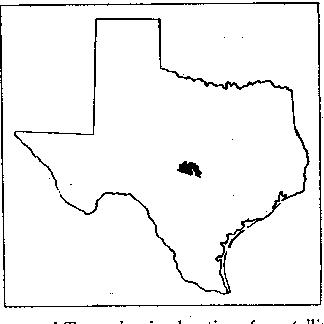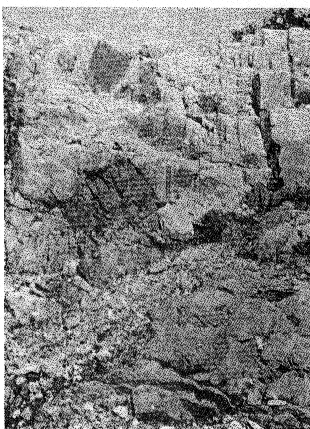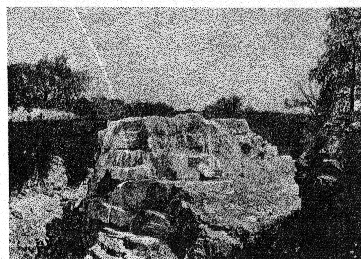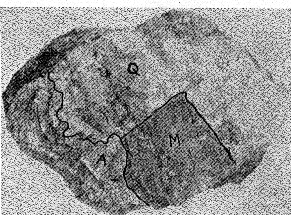
|
|
Volume 17, pages 381-390, 1932 INTRODUCTION The Baringer Hill pegmatite lies near the eastern edge of the Central Mineral (Llano) Region (Fig. 1) about 100 miles northwest of Austin, Texas. The nearest towns of any consequence are Burnett, 16 miles east, and Llano, about 22 miles southwest. Access to the pegmatite is by way of a country road from Bluffton, a settlement on the Burnett-Llano highway, about four miles northeast of Baringer Hill. However, this very interesting area is shortly to be submerged due to the development of a hydro-electric project.1
FIG. 1. Outline map of Texas showing location of crystalline rocks composing the Central Mineral Region. The Baringer pegmatite was discovered in 1887 and was the scene of intermittent quarrying until 1907. The leading figure in the mining operations during this period was William E. Hidden who wrote a series of papers describing the local minerals, many of which where new. The deposit was worked mainly for the yttria minerals, which were utilized in the manufacture of glowers for Nernst lamps. 2The writer visited Baringer Hill in September, 1930. He was accompanied by Professor Fred Bullard of the University of Texas, to whom he is indebted for many courtesies including the furnishing of the photographs used in figures 2 and 3. Expenses in the field were covered by a grant from the Graduate Research Fund, University of Kansas. GENERAL GEOLOGY The Baringer Hill pegmatite is intruded into Algonkian (?) granite, which in turn is intruded into the Valley Spring and Packsaddle metamorphic formations. A number of other pegmatites beside that at Baringer Hill occur in the Central Mineral Region, some of which likewise contain rare earth minerals, but no others have been developed to any extent. Baringer Hill lies on the west bank of Colorado River. Paige describes it as follows: "It is a low mound rising about 40 feet above the river which has here a flood plain about one-fourth mile wide. The hill is formed by an irregular pipe or a short dike of pegmatite which has been more resistant to erosion than the surrounding rock, which is a coarse porphyritic granite with feldspar phenocrysts about an inch long and which disintegrates rapidly." 3THE PEGMATITE GENERAL DESCRIPTION. The outcrop of the pegmatite is about 100 feet wide and from 200 to 250 feet long, with the longer axis running east and west. 4 At the time of the writer's visit three rock types could be distinguished in the pegmatite. Graphic granite occurs in a peripheral zone several feet thick. Inside of this zone the greater part of the pegmatite consists of masses of pink microcline (perthite) and milky quartz which in places are as great as 40 feet in maximum dimension. Near the center of this coarse quartz-microcline aggregate occurs in a vertical shoot the third type of rock which due to its distinctive red color will hereafter be referred to as "red rock." It is the rock in which the greater part of the rare earth minerals are found.ROCK TYPES. The graphic granite has a most striking appearance, being, as Hess has stated, more like the text-book illustrations than the usual graphic granite. 5 The quartz-feldspar ratio varies from about one to one to one to ten, with feldspar much the more abundant on the average. The feldspar is a microcline-albite perthite, with the albite decidedly subordinate. The latter is much less kaolinized than the microcline. In some hand specimens of the graphic granite the microcline cleavage extends across the specimen. The quartz rods are up to 4 centimeters in length and vary from hair width to one-half centimeter. Thin sections of this rock show microcline in single large individuals which have simultaneous extinction over the entire slide, while the quartz rods do not extinguish simultaneously. Strong evidence for a replacement origin of the graphic granite may be seen in the thin sections. Microcline was the host mineral and it completed its crystallization before quartz was introduced. The evidence that replacement took place follows:1. "Islands" of microcline occur in quartz with orientation parallel to the microcline "mainland." 62. The quartz is vein-like while the microcline is not. 3. The quartz rods bifurcate and send apophyses into the microcline. They transgress the albite lamellae, as has also been noted by Schaller. 7 Vogt7a has recently answered this point of Schaller's by stating that the quartz rods do not cut the albite lamellae, as the latter formed through exsolution (according to to Anderson) and stopped at the quartz rods. However, the perthitic albite of the Baringer Hill pegmatite is the "vein" type which both Anderson and Alling7b ascribe to either deuteric or hydrothermal activity. It is very definitely older than the quartz. The writer is in agreement with Vogt and Fersman that the elongation of the quartz rods apparently has nothing to do with the planes of weakness of the feldspar, but he disagrees with Vogt's implication that graphic granites can be explained only by a simultaneous crystallization of quartz and microcline. The interdependent crystallographic arrangement of the quartz and microcline described by Fersman might also be obtained through intermolecular replacement.The normal pegmatite consists of milky quartz and perthitic microcline. The latter often exhibits square outline (Fig. 2), and continuous cleavage faces extending several feet may be observed. The microcline is visibly perthitic and the percentage of albite is materially greater than in the graphic granite microcline. Some of the feldspar masses reach dimensions as great as 30 feet, and even larger quartz masses may be observed. A large quartz pillar occurs near the center of the pegmatite which has been left standing as it is practically barren of rare earth minerals (Fig. 3).
FIG. 2. Microcline crystal surrounded by quartz. The red rock differs from the normal pegmatite in that its feldspar is red albite instead of pink microcline. The albite occurs in thick tabular individuals up to 10 cm. in length and in coarsely granular masses. Microcline, when present, is decidedly subordinate. Quartz occurs abundantly in the red rock in both irregular grains and elongate crystals. The latter tend to parallel the tabular albite crystals, giving the rock a graphic texture, which does not approach the perfection of the peripheral rock, however. Thin sections of the graphic red rock show the presence of albite lamellae, in part transverse to the tabular albite. The writer believes that this transverse albite is older albite which was present in the microcline perthite of the normal pegmatite, and that the tabular albite has replaced the perthite to such an extent that the original microcline has almost disappeared. Derry has described red albite replacing microcline in the pegmatites of southeastern Manitoba. 8 His albite, however, has a much finer grain than that at Baringer Hill. Cutting through the red rock are abundant magnetite veins. Much less abundant, but largely confined to this rock, are the rare earth and associated minerals.
FIG. 3. Barren quartz pillar near center of Baringer Hill pegmatite. MINERALS OF THE PEGMATIVE RARE EARTH MINERALS. The rare earth minerals are quantitatively insignificant, and Hess has estimated that they form but a small fraction of one per cent of the mass of the pegmatite.9 Consequently it is very difficult to find them in place. Professor Bullard and the writer had their best success in collecting specimens of the rarer minerals from a spot a number of yards southwest of the hill where the miners had cobbed and sorted the minerals. The most abundant of the specimens so obtained was allanite. This mineral tends to form large masses rather than veins. One such mass was reported to have weighed over 300 pounds.10 Surrounding the allanite were albite and radially shattered quartz. Gadolinite has been found in masses up to 200 pounds.11 This mineral is heavy and black in color, as allanite, but differs from that mineral in having an irregular, instead of a smooth conchoidal, fracture. The gadolinite masses collected were associated with cyrtolite, fergusonite, and albite. Fergusonite remains fresh longer than the associated gadolinite and albite. It has a typical liver-brown color and a few specimens had a coating of autunite. Some of the fergusonite was found in radially shattered iron-stained quartz. Cyrtolite, one of the more abundant rare earth minerals at Baringer Hill, is readily distinguished from the other minerals in the pegmatite by its curved crystal faces. It is generally surrounded by albite. Cyrtolite is of especial interest because it is now considered the most important source of hafnium,12 and the submergence of Baringer Hill will make one of the possible sources of this mineral no longer accessible. Some small grains of uraninite (nivenite) were found among the material collected. They were invariably surrounded by a brick-red substance with a resinous luster which has heretofore been called gummite. However, it had an index higher than 1.71 which does not accord with the usual published data for gummite. A number of other rare earth minerals are listed by Hess,13 including yttrialite, rowlandite, polycrase, and mackintoshite and several oxidation products beside autunite and gummite. OTHER MINERALS. The minerals of the normal pegmatite, microcline and quartz, are of course of greatest quantitative importance. Where the normal pegmatite lies in contact with the red rock the border between the two is a replacive one with quartz and microcline the host minerals (Fig. 4). No orthoclase was noted among the feldspar specimens collected by the writer. Fluorite occurs both in the quartz, where crystals measuring a foot across have been obtained ,14 and in the red rock. Albite is of greatest abundance in the red rock and it also occurs in crystals lining cavities.15 One specimen collected by the writer contained a large number of drusy albite crystals with maximum dimensions of two centimeters. Quartz occurs in two generations. The earlier quartz is that of the normal pegmatite and the peripheral graphic granite, while the later quartz occurs in the red rock and in crystals in cavities. Regarding the latter occurrence Hidden says: "A cavity into which a horse could have been put was discovered on the river side of the mine and from it a large crystal of smoky quartz was taken that weighed over 600 pounds."16 Hidden also found amethysts occurring in cavities in feldspar. The only other mineral in abundance in the pegmatite is magnetite. It cuts through the red rock in veins averaging about 2 mm. in thickness.
FIG. 4. Albite (A) replacing microcline (M) and quartz (Q). Magnetite also occurs in small crystals and in spheroidal granular masses. Thin books of biotite, associated with albite, were collected by the writer, but very much larger masses were found by Hidden: "Masses of biotite four feet across were met with and always indicated the presence nearby of the rare earth minerals."17 Ilmenite, lepidolite, hematite, rutile, chalcopyrite, pyrite, sphalerite, and molybdenite have also been noted as occurring at Baringer Hill.18 SEQUENCE OF MINERALIZATION The minerals in the Baringer Hill pegmatite were deposited in definite sequence during two distinct phases. The first of these phases was essentially magmatic, while the second was hydrothermal. The space occupied by the minerals forming during the first phase was in most part space previously occupied by the pegmatite magma with replacement of secondary importance, while in the second phase replacement was the dominant process. FIRST PHASE. The sequence of events during the first phase is considered to have been as follows: 1. Intrusion of pegmatite magma. This magma contained abundant water and other volatile constituents and was presumably a residual concentrate of the magma which formed the surrounding granite. The effect of the volatiles was largely to decrease viscosity and lower the temperature of crystallization so that large crystals could form. 2. Crystallization of microcline, with the formation of crystal outlines in part. 3. Partial replacement of microcline by albite, producing perthite. This replacement was due to reaction between the microcline and the residual very mobile pegmatite magma. Alling 19 calls such perthite deuteric.4. Crystallization of quartz, forming very large masses toward the center of the pegmatite and replacing the microcline in the peripheral zone in such a manner as to form graphic granite. The evidence for the replacement origin of the graphic granite has already been given. The crystallization of the quartz completed the solidification of the pegmatite magma through that part of the pegmatite now at or close to the surface. SECOND PHASE. The volatile constituents of the pegmatite magma did not enter into the composition of the minerals formed during the first phase. Consequently, with the crystallization of the pegmatite magma to successively lower depths in the pipe-like intrusive, the residual magma became richer and richer in volatiles, eventually becoming a hydrothermal solution. Some of this solution escaped upward through the pegmatite (the easiest channel of escape) dissolving older minerals and depositing new ones as it did so. Evidences of this hydrothermal activity are the general confinement of the minerals classified in the second phase to a restricted part of the pegmatite (the red rock shoot), their constant association with each other, and the presence of irregular veins and other criteria of replacement which will be described in more detail subsequently. The sequence of mineralization during the second phase was as follows: 1. Deposition of fluorite. This mineral is decidedly veined and otherwise encroached upon by albite. 2. Albitization. Subsequent to the deposition of fluorite. the ascending solutions deposited great quantities of albite, forming the red rock previously described. Fig. 4 illustrates the replacement of quartz and microcline by albite. As would be expected, the solutions dissolving microcline and depositing albite were unable to dissolve the albite in the original perthite. This explains the presence of older albite in the red rock thin sections. Albite is an invariable associate of the rare earth minerals. Similar associations have been described by Spence: "In as far as the writer's own observations on the granite pegmatites of eastern Canada are concerned, soda-rich feldspar . . . . is particularly in evidence around the rare element minerals, allanite, cyrtolite, titanite, monazite, etc. Albitization of original microcline in such situation may, therefore, be presumed to have taken place." 20 Albitization was accompanied by cavity formation, due to solution exceeding precipitation in parts of the pegmatite. Various points substantiating the theory that cavities in pegmatites are formed by hydrothermal solution have been given by the writer elsewhere.21 The large cavity already described and smaller cavities noted by Hidden and Mackintosh22 were formed during this stage. Some became lined with albite crystals while later solutions deposited quartz crystals in others.3. Deposition of quartz (second generation) both in the red rock (giving portions of this rock a graphic texture) and as euhedral smoky and amethystine crystals in cavities. 4. Deposition of rare earth and accompanying minerals. The hydrothermal phase was completed with the deposition of the rare earth minerals and magnetite, biotite, ilmenite and other minerals. Undoubtedly these minerals likewise were precipitated in definite sequence, but they are so rarely found in juxtaposition that it was impossible for the writer to work out the details of the sequence. As a general rule the minerals in this final group are confined to the red rock, as in the case of the magnetite veins, although in a few places the depositing solutions worked out into the normal pegmatite and there precipitated. Thus Hess noted the presence of lithium mica in cracks in the quartz. 23 Likewise some of the rare earth minerals were deposited in massive quartz. Where this occurs the surrounding quartz is radially shattered. According to Hidden these "stars" were sometimes 8 to 10 feet across. They always had thorium, uranium or zirconium minerals at the center and thus acted as a guide to ore.24 In the writer's opinion the best explanation for such stars has been given by Hess and Wells: "The radial cracks surrounding minerals and pegmatites are connected with the growth of minerals .... The growth took place faster than the older mineral is replaced, breaking the rock radially."25CONCLUSION The Baringer Hill pegmatite differs from those of New England and the Black Hills not only in suite of minerals but also in its dearth of accessory minerals in the earliest formed pegmatite. Due to the latter characteristic the original pegmatite could be classified as alaskite-pegmatite. NOTES 1 Brown, L. S., A new report on the Baringer hill district of Texas: (abstract) Amer. Mineral., vol. 15, p. 122, 1930. 2 Hess, Frank L., Minerals of the rare earth metals at Baringer Hill, Llano County, Texas: U. S. Geological Survey, Bull. 340, pp. 286-294, 1908. 3 Paige, Sidney, Description of Llano and Burnett quadrangles: U. S. Geological Survey, Folio 183, p. 12, 1912. 4 Hess, Frank L., Op. cit., p. 288. 5 Op. cit., p. 288. 6 Bastin, E. S., et. al., Criteria of age relations of minerals: Econ. Geology, vol. 26, p. 599, 1931. 7 Schaller, W. T., Mineral replacement in pegmatites: Amer. Mineral., vol. 12, p. 61, 1927. 7a Vogt, J. H. L., The physical chemistry of the magmatic differentiation of igneous rocks. Skrifter utgit av Det Norske Videnskaps-Akademi i Oslo. I Mat.Naturv. Klasse, No. 3, Second Half, 1930, p. 126. 7b Alling, H. L., Perthite: Amer. Mineral., vol. 17, p. 60, 1932. 8 Derry, D. R., The genetic relationships of pegmatites, aplites, and tin veins: Geol. Mag., vol. 68, p. 462, 1931. 9 Op. cit., p. 293. 10 Hess, op. cit., p. 291. 11 Hess, F. L., The Baringer Hill pegmatite dike: Science, vol. 27, p. 537, 1908. 12 Lee, Ivan., Journal Industrial Engineering Chemistry, news edition, Feb. 10, 1930, p. 10. Abstract in Foote-Prints, vol. 3, no. 2, 1930. 13 Op. cit., pp. 291-293. 14 Hess, F. L., op. cit., p. 289. 15 Hidden, W. E. and Mackintosh, J. B., A description of several yttrium and thorium minerals from Llano County, Texas: Am. Jour. Sci., (3), vol.38, p. 476. 1889. 16 Hidden, W. E., Some results of late mineral research in Llano County, Texas: Am. Jour. Sci., (4), vol. 19, p. 427, 1905. 17 Op. Cit., p. 427. 18 Hess, op. cit., pp. 291-293. 19 Alling, H. L., Op. cit., p. 54. 20 Spence, Hugh S., Pegmatite minerals of Ontario and Quebec: Amer. Mineral., vol. 15, p. 494, 1930. 21 Amer. Mineral., vol. 10, pp. 364-366, 1925. 22 Op. cit., p. 476. 23 Op. cit., p. 289. 24 Hidden, W. E., Some results of late mineral research in Llano County, Texas: Am. Jour. Sci., Vol. 19, p. 433, 1905. 25 Samarskite from Petaca, New Mexico: Am. Jour. Sci., Vol. 19, pp. 17-26, 1930. [var:'startyear'='1932'] [Include:'footer.htm'] |



